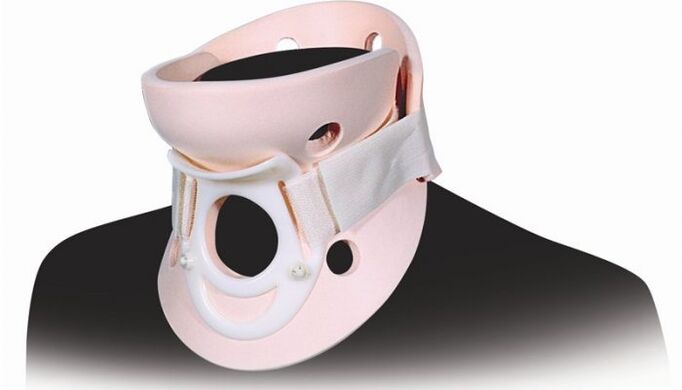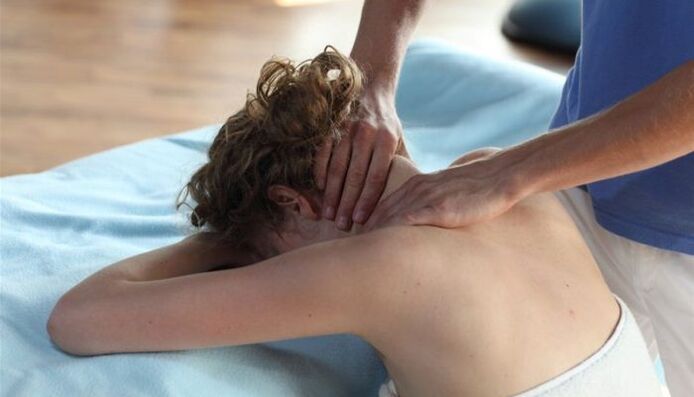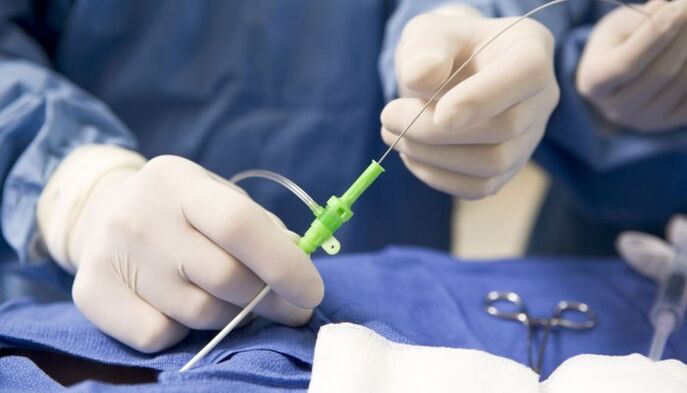How to cure cervical osteochondrosis? This question is asked by many patients and doctors around the world. Degenerative diseases of the musculoskeletal system are very difficult to treat and cause a wide variety of complications. In these conditions, the question of effective therapy is extremely relevant.
Osteochondrosis of the cervical spine.

Before finding out whether cervical osteochondrosis can be cured, it is worth understanding the very essence of this disease. Osteochondrosis is a degenerative process that begins in the intervertebral discs, the layers of cartilage between each two adjacent vertebrae.
Let's imagine an intervertebral disc. It consists of an inner soft part, the nucleus pulposus, and an outer layer, the fibrous capsule. This is what gives a certain shape to the soft part so that the core can fulfill its shock-absorbing function.
In osteochondrosis, the primary degenerative process occurs precisely in the fibrous capsule:
- Under the influence of damaging factors, a defect is formed.
- The soft nucleus of the disc passes through it and a bulge of the spinal discs is formed.
- As the process progresses, part of the nucleus falls out and a herniated disc forms.
All of these processes involve inflammation of the surrounding tissues. First, a reflex pain syndrome develops, and then a compression syndrome - the hernia compresses the nerve roots.
This process can occur anywhere in the spine. One of the most common locations is the neck. Is it possible to cure osteochondrosis of the cervical spine?
Treatment options
Understanding the essence of the disease and the mechanism of its development, we can assume what methods can completely and permanently cure the patient of this disease.
There are several different effects that we can expect from any method of therapy: symptomatic (eliminates the manifestations of the disease), pathogenic (disrupts the pathological mechanism of development), etiological (directly affects the cause of development).
In osteochondrosis, the cause is a wide variety of risk factors for the disease. It is impossible to influence them if the disease already exists. However, preventive measures are specifically aimed at eliminating the causes.
Many treatment methods have a possible pathogenic effect, and this is what we will try to find in each of the methods proposed by modern medicine.
The symptomatic effect is also very important. The full course of therapy prescribed by the treating physician should always include an impact on the manifestations of the disease, because during therapy it is necessary to alleviate the patient's state of health.
Among the variety of treatment methods, we will try to understand the following treatment options:
- Drug exposure.
- Orthopedic products.
- Physiotherapy.
- Physiotherapy, massages, manual therapy.
- Column operations.
- Radiofrequency ablation.
It is necessary to say a few words about prevention, which allows you to completely avoid the onset of the disease.
drug therapy

Not all medications that a doctor prescribes for osteochondrosis help to eliminate it. Many drugs perform a purely symptomatic function:
- Non-steroidal anti-inflammatory drugs: eliminate inflammation.
- Muscle relaxants: prevent reflex muscle spasms.
- Local analgesics: relieve pain.
- Vascular agents - used for cervical osteochondrosis in combination with vertebral artery syndrome.
- Glucocorticosteroids - these hormonal drugs have a pronounced anti-inflammatory effect.
Still, several drugs have a pathogenic effect. First of all, it is worth mentioning chondroprotectors. These drugs are used only in the early stages of osteochondrosis, when there is no herniated disc yet. They slow down the degeneration process and prevent the formation of bumps. It must be taken for a long time and constantly, but the therapeutic effect will be quite significant.
B vitamins - these drugs do not affect the degeneration process itself and do not help to cure osteochondrosis. However, it is very important to use them in the presence of reflex or compression syndromes. Vitamins support metabolism in nervous tissue and prevent nerve death.
Therefore, among all medications, only timely prescribed chondroprotectors help to eliminate cervical osteochondrosis.
Orthopedic products

The next treatment method, very popular in modern medicine, is the use of orthopedic devices. The use of corsets, bandages and orthoses is widespread.
For cervical osteochondrosis, collars are most often used, but there are other types of orthopedic devices. These products effectively eliminate pain, which is beyond doubt. However, can they influence the course of the disease?
For the treatment of osteochondrosis, the following features of this type of therapy are important:
- Corsets and collars have a compression effect: they put pressure on a certain part of the spine. This prevents the appearance of bulges and hernias, that is, the formation of complications.
- Orthopedic devices always separate the vertebrae from each other in a vertical plane. This helps relieve pressure on the nerve roots and the intervertebral discs themselves.
- If there are bumps or degenerative changes, the corset will not help eliminate them. However, when used regularly, the remedy helps not to remember the manifestations of the disease.
The listed properties should be taken into account not only by the doctor, but also by the patient, so as not to expect too much from the use of bandages.
Physiotherapy

Therapeutic exercises are one of the most underestimated methods by patients to treat orthopedic diseases. It is regular exercises and activities that help eliminate most of the manifestations of any disease.
Osteochondrosis is no exception. In case of pathology of the cervical spine, physical activity has the following healing properties:
- Exercises help eliminate pain, reflex muscle spasms and compression effects on the vertebral artery and other vessels. This means that with regular exercise, you can reduce the need for symptomatic therapy.
- The exercises help to form the muscular corset of the cervical spine. Trained muscles support internal structures, including bones and cartilage, and prevent bulges from forming.
- Degenerative changes in the disc develop under the influence of excessive, incorrectly applied load or its deficiency. Adequate exercise prevents the degenerative process and activates blood flow in the area of the intervertebral discs.
Even knowing about the beneficial effects of exercise, many patients are lazy to do the exercises. Start training with a specialist and then implement it into your daily routine. Soon you will not be able to imagine your day without exercise and a series of useful exercises.
Physiotherapy and massages.

Quite controversial treatment methods are physiotherapy and massage. These methods certainly help alleviate some of the symptoms of the disease. Neck massage helps eliminate muscle spasms, and physiotherapy relieves inflammation, pain and prevents the appearance of compression syndrome.
But can these methods cure cervical osteochondrosis? The pathogenic effect is achieved only as part of a complex treatment. Physiotherapy and massage should be used in conjunction with physical therapy and the use of medications. The effects of different treatment methods enhance each other:
- Electrophoresis and phonophoresis help medications reach the spine.
- Manual therapy relaxes muscles after prolonged exercise.
- Acupuncture and electromyostimulation in combination with exercise therapy create a strong muscle corset and eliminate pain.
More examples can be given of the combined effect of various therapy methods.
We must also not forget that all physiotherapy and massage methods increase local blood flow and, therefore, metabolism in damaged tissues. As a result, degenerative processes slow down or stop completely.
Surgical treatment

In some cases, intervertebral disc pathology can only be eliminated by surgery. This method also cannot be considered an etiological treatment: the surgeon does not act on the cause of the disease, but eliminates its consequences. However, in the presence of local osteochondrosis, surgery can help eliminate its symptoms permanently.
There are several methods of surgical intervention, but most are reduced to two options:
- Plastic disc surgery with palliative measures. During the operation all complications of the disease are also eliminated.
- Intervertebral cartilage prosthesis or replacement of the entire vertebral movement segment with a prosthesis.
Regardless of the chosen treatment method, relapses of cervical osteochondrosis are possible. The disease can affect any other adjacent intervertebral disc. To prevent this from happening, preventive measures are taken.
It is also worth remembering the need for postoperative rehabilitation. Many of the above therapy methods help restore performance. It is convenient to combine them during treatment in the sanatorium.
radiofrequency ablation

A very effective and promising treatment method is radiofrequency ablation. Not so long ago, this method was not known at all, but now ablation is carried out in many large cities.
The essence of the procedure is as follows:
- Using a needle puncture, a special electrode is applied to the damaged intervertebral disc.
- The disc is heat treated with electricity.
- Destruction of the nerves and the disc tissue itself occurs in the impact area.
- After ablation, the disc remains between the vertebrae. It is not capable of performing a shock absorption function, but does not cause pathological symptoms.
The advantages of the method are the absence of the need for general anesthesia, the short duration of the procedure and rapid recovery. The technique can be used as the first stage of treatment if symptoms have not been completely relieved.
In most cases, ablation helps to eliminate all symptoms of osteochondrosis, but the patient is not immune to the damage of this disease to other intervertebral discs.
Prevention

From the above we can conclude that all modern treatment methods only help to prevent the progression of cervical osteochondrosis or eliminate its manifestations only on a specific disc. There is a high probability of recurrence of the disease and its spread to adjacent cartilage layers.
This process cannot be eliminated, but it can be prevented. For this, numerous methods are used to prevent osteochondrosis.
If the disease has just started to bother you, has happened to many family members, or you have been treated for osteochondrosis, follow these tips:
- Normalize physical activity in the spine and neck in particular. Perform preventive exercises, go swimming, skiing. Do not allow your neck to remain still for long periods of time.
- Eat well. A balanced diet, free of harmful foods and containing sufficient amounts of protein and calcium, will help prevent the disease.
- Eliminate bad habits that can cause a degenerative process. First of all, it involves frequent smoking and drinking alcohol.
- When sleeping, use appropriate orthopedic aids and mattresses to avoid additional stress on the cervical spine.
- If you have spinal diseases or injuries, be sure to use orthopedic products.
Simple preventive measures help support the cervical spine and prevent the development of osteochondrosis.


















